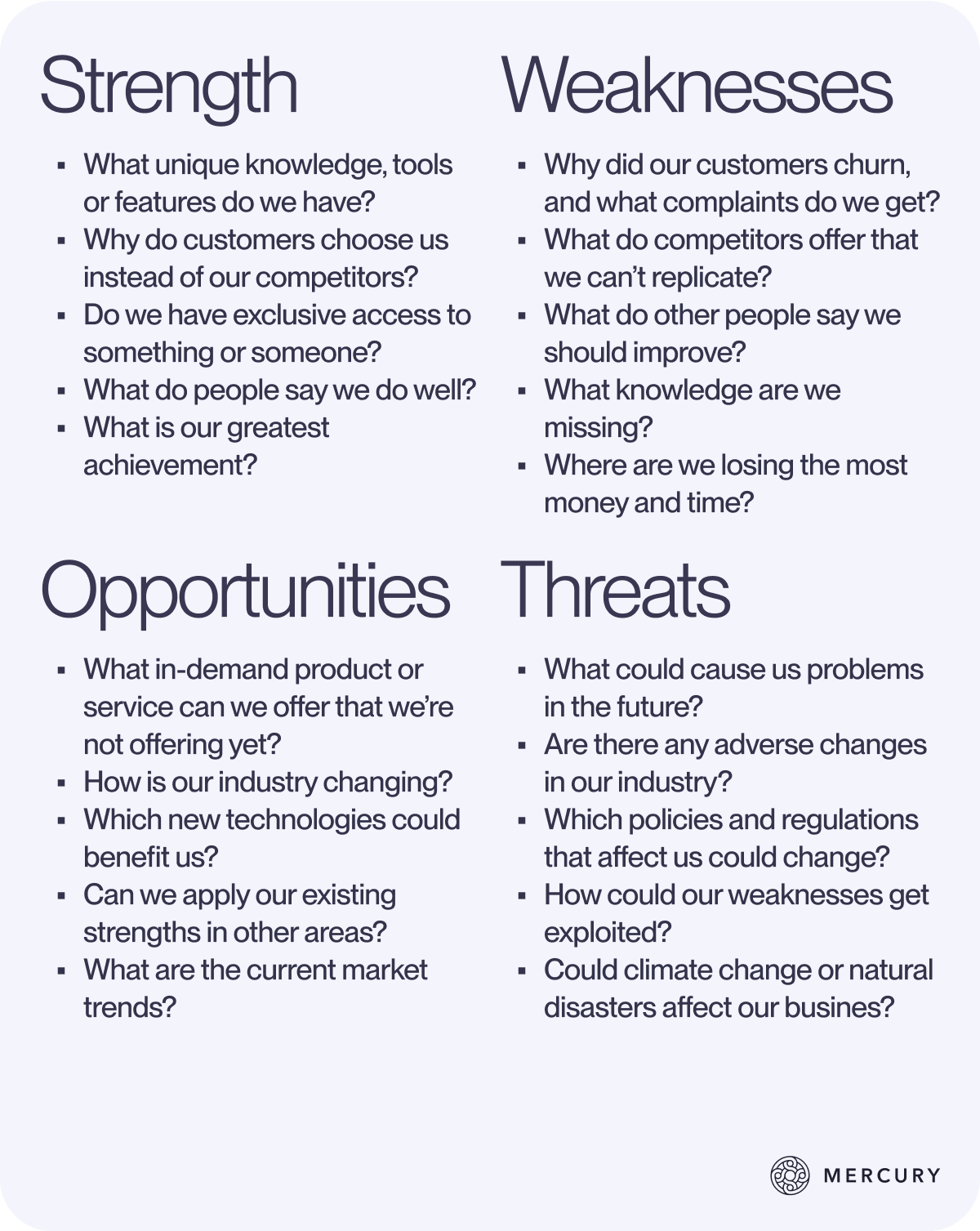How to do a SWOT analysis

Everything moves quickly in the first couple of months of a startup, and founding teams often find themselves making decisions based on gut feelings. But for big decisions, you need something more strategic. That’s where a SWOT analysis — or, situational analysis — can come into play. This simple framework is designed to help you navigate complex situations and make well-informed decisions rooted in data, facts, and thoughtful insights.
In this article, we’ll explain how to write an effective SWOT analysis for your new business, when you need one, and what to do next.
What is a SWOT analysis?
SWOT stands for strengths, weaknesses, opportunities, and threats. Strengths and weaknesses are internal factors — everything that’s more or less within your control or relevant to your core competencies as a company. Opportunities and threats are external factors — things that are mostly out of your control and related to the broader industry, market, or ecosystem.
In a SWOT analysis, you’ll explore these internal and external factors through fact-based analysis and introspection. It’s a great tool to find fresh perspectives and make well-informed decisions. And the beauty of it? It’s very accessible, even for new founders.
By evaluating your company's competitive position, identifying dangerous blindspots, and finding hidden opportunities, the SWOT analysis gives you a more objective, informed foundation on which to base key decisions and plans. And this can be true for a number of situations that arise — from decision-making and planning moments, like deciding whether to launch a new product or make a big organizational change, to big-picture assessments, like analyzing the performance of your business as a whole. You just have to set clear objectives to stay on track and understand what you’re looking to assess.
Components of the SWOT analysis
Like we mentioned, the SWOT analysis is broken into four categories: strengths, weaknesses, opportunities, and threats, where strengths and weaknesses are the internal factors and opportunities and threats are the external. Below, we break them down a little further:
Strengths
Strengths are, of course, the things you’re good at compared to your competitors. Examples of strengths that show up on your SWOT analysis might be:
- Recent investments or a large amount of working capital
- Unique technology and innovative features
- A prestigious team of investors
- A skilled and motivated team
- Past job experiences
- Relevant connections
Weaknesses
Weaknesses are those things holding you back — the factors that might be standing in the way to success because you haven’t quite mastered them or pinned them down yet as a company. Examples of weaknesses might include:
- A weak brand and online presence
- An inadequate supply chain
- A lack of working capital
- No product-market-fit
- Important skill gaps
Opportunities
Opportunities are the external or environmental factors that could work to your company’s advantage in the near future, assuming you seize them accordingly. Examples of opportunities might include:
- A new technology that makes work easier (Generative AI, anyone?)
- Growing awareness of the problem you solve
- A competitor ceasing operations
- A positive shifts in regulations
Threats
Conversely, threats are any external factors that have the potential to hurt your company or affect business in a negative way. Examples here might include:
- Competitors with more funds
- A change in regulation or policy
- New legal restrictions imposed on your industry
- Economic conditions that negatively impact your customers’ buying power
- Rising costs for materials
- Tight labor supply
- A sharp decline in VC investments

Why is a SWOT analysis important for companies?
The SWOT analysis is an effective tool to make smarter business decisions, anchored less in assumption or bias and more in fact and objectivity — and this is true for companies of all sizes, whether the SWOT is assessing a market opportunity for emerging startups or helping chart the future’s course for a mature venture.
This 360-degree perspective is important because it gives context to the decision you’re trying to make, and it can lead to interesting insights about your company:
- Are you investing your time and money in the right marketing channels?
- Are you focusing on the right product and market, or should you pivot?
- How is your startup performing compared to its competitors?
- What are the opinions of customers and stakeholders?
- What’s holding you back from reaching your goals or entering a new phase of growth?
Conducting a SWOT analysis also gives you a written record of past decision-making processes. This will allow you to track past situations, wins, and mistakes.
When should you do a SWOT analysis?
A SWOT analysis is a valuable tool in many situations, but there are three use cases in particular where the decision-making framework can give way to particularly interesting insights:
- When you’re preparing to launch a new company
- Before you make a significant strategic decision
- When you’re expecting significant ecosystem shifts or external changes
You can perform an analysis as often as needed but mind that they’re time-consuming — and time is a very scarce asset.
How SWOT compares to other strategy frameworks
SWOT is one of the most accessible strategy tools for founders, but it’s not the only framework available. In practice, teams often use SWOT alongside other models that zoom in on specific questions, like external forces, competitive dynamics, or internal capabilities.
Here’s how a few popular alternatives compare:
- PESTLE analysis: Looks at Political, Economic, Social, Technological, Legal, and Environmental forces shaping your environment. It’s especially useful for scanning macro trends and regulatory shifts before you fill in the “Opportunities” and “Threats” parts of your SWOT.
- Porter’s Five Forces: Focuses on competitive pressure in your industry — new entrants, substitutes, supplier power, buyer power, and competitive rivalry — popularized by Michael Porter in Harvard Business Review. It goes deeper on external competition than a standard SWOT. (https://www.isc.hbs.edu/strategy/business-strategy/Pages/the-five-forces.aspx)
- VRIO/VRIN: Evaluates whether your resources and capabilities are Valuable, Rare, Hard to Imitate, and Organized to Capture Value. It’s a way to stress-test which “Strengths” truly create durable advantages.
- SOAR framework: A more positive, aspirational alternative to SWOT. It focuses on Strengths, Opportunities, Aspirations, and Results — useful when you want to rally a team around future vision rather than catalog every threat and weakness.
- Balanced Scorecard: Translates strategy into measurable objectives across financial, customer, internal process, and learning and growth perspectives. While SWOT is a diagnostic snapshot, a Balanced Scorecard is more of an execution and tracking tool.
To see the differences at a glance:
Framework | Primary focus | Best used for | How it complements SWOT |
|---|---|---|---|
SWOT | Internal + external factors (S/W/O/T) | Big-picture situational analysis and decision support | Baseline view of where you stand today |
PESTLE | Macro external environment | Understanding political, economic, and social trends | Deepens the “Opportunities” and “Threats” quadrants |
Porter’s Five Forces | Industry structure and competition | Assessing how hard it is to win in a given market | Sharpens your view of competitive “Threats” and potential “Strengths” |
VRIO/VRIN | Internal resources and capabilities | Identifying sustainable competitive advantages | Validates which “Strengths” really matter long term |
SOAR | Positive, future-oriented planning | Visioning, team alignment, and growth conversations | Shifts focus from problems to possibilities |
Balanced Scorecard | Strategy execution and metrics | Turning strategy into KPIs and ongoing measurement | Helps track whether actions from your SWOT are working |
You don’t have to use all of these at once. Instead, think of SWOT as your entry point — and pull in another framework when you need a deeper lens on a particular question.
How to do a good SWOT analysis?
The best way to do a SWOT analysis is to take it step by step and follow a data-driven approach. Since eliminating bias is one of the biggest challenges for businesses conducting a SWOT analysis, we recommend best practices like setting aside time to gather resources and reports.
Generally, an effective SWOT analysis can be broken down into five key steps:
1. Create a team and determine the objective
Creating a team for your analysis and determining its aims go hand in hand. Having a clear idea of what you want to analyze will help you put the right team together. And the team will help you nail down a specific objective.
Why is this important? Remember that a SWOT analysis can be about anything — from adding a new product to exploring your next financing options or defining your marketing strategy. The better you define the goal of the analysis, the better the results will be.
2. Gather internal and external resources
Because it’s important to base your analysis on facts and avoid bias, we recommend gathering as many resources as possible: financial reports, SEO audits, operational processes, and market insights. The goal is to create a strong picture of the current cultural truths and realities shaping the ecosystem and organizational structure in which you’re operating.
Determine which information is available and what’s lacking. Consider how reliable your information is and what the limitations are. If you’re clear about this before you start the analysis, you’ll avoid drawing false conclusions at the end.
3. Extract information and compile ideas
The third step is what it’s all about: extracting as many insights as possible from your resources. This is where the four factors of the SWOT analysis — the strengths, weaknesses, opportunities, and threats — come into play. Some people recommend taking it one by one but this could be limiting. So, we recommend brainstorming on all possible ideas. One report will likely reveal a mix of insights.
To ensure that you’re getting the most out of this analysis and don’t miss any crucial insights into your core strengths, current market opportunities, competitive landscape, environmental limitations, or otherwise, it can help to start with a list of questions to guide the conversation.
You can also consider layering on different frameworks for analysis to dig deeper. For example, the 4C Framework can be a good way to dig into strengths and weaknesses, while a PEST analysis can help you uncover threats and opportunities.
4. Refine your findings and make a SWOT matrix
You’re probably going to have dozens — if not hundreds — of ideas. There’s going to be some repetition, there may be some contradictions, and not everything will be as important.
So, now’s the time to combine ideas, explore which insights could be wrong, and determine what can be eliminated.
While refining your insights, it’s common practice to put them in a table or SWOT matrix. This is broken into four quadrants, with strengths in the top-left, weaknesses in the top-right, opportunities in the bottom-left, and threats in the bottom-right.
In your matrix, you’ll write concise bullet points with the key insights from your analysis. There’s no perfect number of bullet points — just don’t overdo it. You don’t want to overwhelm yourself. So, focus on the biggest strengths, weaknesses, opportunities, and risks in front of you. Write down what will have the biggest impact, and ignore what’s unlikely to affect your business. Finally, it’s best practice to reorder the bullet points and put the most important insights on top.
5. Analyze your findings and develop a strategy
Complete your SWOT analysis with an action plan. Look for potential connections between the quadrants of your matrix and figure out what to do next.
Here are some questions to guide you:
- Which opportunities are more likely to happen if we work on our weaknesses?
- Which threats will be more dangerous if we don’t deal with our weaknesses?
- How can we take advantage of our strengths?
- How should we monitor and mitigate threats?
Focus on prioritizing next steps based on effort and potential reward — things that will take minimal effort but offer a greater reward are more valuable than things that will take a lot of effort and barely move the needle. (And they’re more valuable than high-effort, high-reward actions as well.) Focus on putting your time and effort towards things that will make the biggest impact for your company with the least commitment of resources possible.
From SWOT to TOWS: turning insights into strategy
A SWOT analysis is only as valuable as the actions you take away from it. Once you’ve filled in your strengths, weaknesses, opportunities, and threats, the next step is to turn those insights into concrete strategic moves.
That’s where the TOWS matrix comes in. TOWS uses the same four categories as SWOT, but rearranges them and asks you to systematically connect internal and external factors to generate strategies.
In a TOWS matrix, you’ll typically explore four types of strategies:
- SO (Strength–Opportunity) strategies: How can you use your strengths to capitalize on your biggest opportunities?
- ST (Strength–Threat) strategies: How can you use your strengths to neutralize or reduce key threats?
- WO (Weakness–Opportunity) strategies: What weaknesses must you address to unlock promising opportunities?
- WT (Weakness–Threat) strategies: Where do your weaknesses magnify threats, and what should you avoid or fix first?
Practically, that means:
- Listing your most important strengths, weaknesses, opportunities, and threats.
- Drawing connections between them in each quadrant (SO, ST, WO, WT).
- Turning those pairings into specific actions or initiatives — for example, “Use our strong developer brand (S) to recruit faster in new markets (O),” or “Address our lack of regulatory expertise (W) before entering a heavily regulated vertical (T).”
If SWOT gives you a clear picture of where things stand, TOWS gives you a shortlist of strategies you can actually execute.
How do you quantify or measure items in a SWOT analysis?
SWOT is often treated as a purely qualitative exercise — just lists of bullet points in four boxes. But you can get more value from the framework by lightly quantifying what you find.
A few simple ways to do that:
- Score each item on impact: For every strength, weakness, opportunity, or threat, give it a 1–5 score for how much impact it could have on your objective if it changed.
- Score each item on likelihood: For external opportunities and threats, you can also estimate how likely they are to materialize over your planning horizon.
- Apply weights: If some factors clearly matter more than others (for example, regulatory changes vs. a minor competitor), you can assign higher weights to those items when you prioritize actions.
- Rank within each quadrant: Once you’ve scored everything, reorder your bullet points so the most important items are at the top of each quadrant — this makes it easier to focus your discussion.
You don’t need a complex model or perfect numbers. The goal is simply to move from “a long list of observations” to a data-informed, prioritized view of what matters most. That, in turn, makes it easier to build a TOWS matrix and choose your next moves.
Common mistakes to avoid in a SWOT analysis
Because SWOT is so simple, it’s also easy to do poorly. A few pitfalls show up again and again:
- Listing too many vague items: Long, generic lists (“good product,” “tough market”) don’t help with decision-making. Focus on specific, high-impact factors and be ruthless about prioritizing.
- Mixing internal and external factors: Strengths and weaknesses should be internal to your company; opportunities and threats should describe your environment. Blurring those lines makes it harder to see what you can actually control.
- Treating SWOT as a one-time exercise: Markets, teams, and products evolve quickly. If you only do a SWOT once during an offsite and never revisit it, the analysis will go stale.
- Stopping at the matrix: A SWOT with no follow-through is just a workshop artifact. You need a clear action plan — ideally using a TOWS matrix or similar strategy layer — to turn insights into initiatives.
- Ignoring dissent or inconvenient findings: If your analysis only reinforces what leadership already believes, it’s not doing its job. Make space for uncomfortable insights and conflicting perspectives.
Keeping these risks in mind will help you turn SWOT from a checkbox exercise into a genuinely useful decision-making tool.
Conclusion
A SWOT analysis gives you a simple, structured way to step back from day-to-day chaos and look at your business from multiple angles. Used well, it can surface blind spots, highlight unfair advantages, and spark better conversations about where to focus next.
On its own, though, SWOT is just a snapshot. The real value comes from what you do afterward — quantifying what matters most, translating insights into strategy with tools like the TOWS matrix, and revisiting your analysis as conditions change. Combined with other frameworks like PESTLE, Porter’s Five Forces, VRIO, SOAR, or a Balanced Scorecard, SWOT can anchor a broader strategy toolkit that grows with your company over time.
Related reads

How AI is influencing early roles at startups

Should you launch on eBay? A viability checklist by product category

The 8 most common inventory mistakes (and how to fix them)
